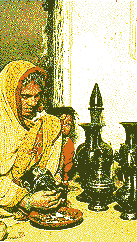|
Introduction
Ancient India's Contribution to Production Technology and Mechanical Engineering
"Many of the advances in the sciences that we consider today to have been made in Europe were in fact made in India centuries ago."
- Grant Duff
British Historian of India
We have been told through Indian as well as foreign literary sources that in ancient times, commodities like sugar, palm oil, coconut oil, cotton cloth, clarified butter, cast iron, tin sheets, copper vessels, dyes and pigments like cinnabar (ochre), indigo and lac, perfumes like sandalwood oil, musk tamarind, costus, macir, camphor, and even crude glass crockery were being exported from India.(The Periplus of the Erythrean Sea - Travelsand Trade in the Indian Ocean by a Merchant in the First Century, Translated from the Greek and Annoted by Wilfred H. Schoff, Longmans Green and Co. New York, 1912)
These items are not gifts of nature, their manufacture involves processing to effect chemical changes in their properties notably in the case of sugar, glass, metals and perfumes. Thus some kind of chemical engineering must have existed in India in those times i.e. about 2000 to 2500 years ago. Alongwith this chemical processing, some physical apparatus would have been used. This presumes the existence of at least a rudimentary knowledge that in today's terminology would be called 'mechanical engineering'.
 The earliest recorded use of copperware in India has been around 3000 B.C. the findings at Mohen-jo-daro and Harappa, bear this out The earliest documented observation of smelting of metals in India is by Greek Historians in the 4th Century B.C.
The earliest recorded use of copperware in India has been around 3000 B.C. the findings at Mohen-jo-daro and Harappa, bear this out The earliest documented observation of smelting of metals in India is by Greek Historians in the 4th Century B.C.
No doubt, the chemical and mechanical engineering would have been very rudimentary by today's standards but nevertheless it would have been chemical and mechanical engineering of some standard as is evident from the following references about the quality of Indian products in foreign literature of those times.
When referring to India, the author of the Greek text Periplus, which is dated around the 1st century A.D. has said, "There is a river near it called the Ganges" .... "On its bank is a market town which has the same name as the river, Ganges. Through this place are brought malabathrum and Gangetic spikenard and pearls and muslins of the finest sorts, which are called Gangetic. It is said that there are gold mines near these places, and there is a gold coin which is called caltis. And just opposite this river there is an island in the ocean, the last part of the inhabited world towards the east, under the rising sun itself, it is called Chryse; and it has the best tortoise-shell of all the places on the Erythrean Sea"2
The Periplus further states that "Nelcynda is distant from Muziris by river and sea about five hundred stadia, and is of another kingdom, the Pandian. This place also is situated on a river, about one hundred and twenty stadia from the sea." ... "They send large ships to these market towns on account of the great quantity and bulk of pepper and malabathrum. There are imported here, in the first place, a great quantity of coin; topaz, thin clothing," "fine linen, antimony, coral, crude glass, copper,tin, lead; wine, not much, but as much as at Barygaza; realgar and orpiment; and wheat enough for sailors," "There is exported pepper which is produced in quantity only in one region near these markets, a district called Cottonara.
Author : Shri Sudheer Birodkar
|